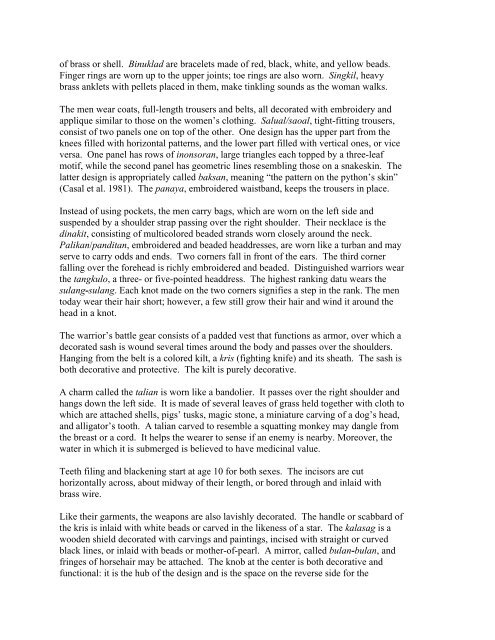Create successful ePaper yourself
Turn your PDF publications into a flip-book with our unique Google optimized e-Paper software.
of brass or shell. Binuklad are bracelets made of red, black, white, and yellow beads.<br />
Finger rings are worn up to the upper joints; toe rings are also worn. Singkil, heavy<br />
brass anklets with pellets placed in them, make tinkling sounds as the woman walks.<br />
The men wear coats, full-length trousers and belts, all decorated with embroidery and<br />
applique similar to those on the women’s clothing. Salual/saoal, tight-fitting trousers,<br />
consist of two panels one on top of the other. One design has the upper part from the<br />
knees filled with horizontal patterns, and the lower part filled with vertical ones, or vice<br />
versa. One panel has rows of inonsoran, large triangles each topped by a three-leaf<br />
motif, while the second panel has geometric lines resembling those on a snakeskin. The<br />
latter design is appropriately called baksan, meaning “the pattern on the python’s skin”<br />
(Casal et al. 1981). The panaya, embroidered waistband, keeps the trousers in place.<br />
Instead of using pockets, the men carry bags, which are worn on the left side and<br />
suspended by a shoulder strap passing over the right shoulder. Their necklace is the<br />
dinakit, consisting of multicolored beaded strands worn closely around the neck.<br />
Palikan/panditan, embroidered and beaded headdresses, are worn like a turban and may<br />
serve to carry odds and ends. Two corners fall in front of the ears. The third corner<br />
falling over the forehead is richly embroidered and beaded. Distinguished warriors wear<br />
the tangkulo, a three- or five-pointed headdress. The highest ranking datu wears the<br />
sulang-sulang. Each knot made on the two corners signifies a step in the rank. The men<br />
today wear their hair short; however, a few still grow their hair and wind it around the<br />
head in a knot.<br />
The warrior’s battle gear consists of a padded vest that functions as armor, over which a<br />
decorated sash is wound several times around the body and passes over the shoulders.<br />
Hanging from the belt is a colored kilt, a kris (fighting knife) and its sheath. The sash is<br />
both decorative and protective. The kilt is purely decorative.<br />
A charm called the talian is worn like a bandolier. It passes over the right shoulder and<br />
hangs down the left side. It is made of several leaves of grass held together with cloth to<br />
which are attached shells, pigs’ tusks, magic stone, a miniature carving of a dog’s head,<br />
and alligator’s tooth. A talian carved to resemble a squatting monkey may dangle from<br />
the breast or a cord. It helps the wearer to sense if an enemy is nearby. Moreover, the<br />
water in which it is submerged is believed to have medicinal value.<br />
Teeth filing and blackening start at age 10 for both sexes. The incisors are cut<br />
horizontally across, about midway of their length, or bored through and inlaid with<br />
brass wire.<br />
Like their garments, the weapons are also lavishly decorated. The handle or scabbard of<br />
the kris is inlaid with white beads or carved in the likeness of a star. The kalasag is a<br />
wooden shield decorated with carvings and paintings, incised with straight or curved<br />
black lines, or inlaid with beads or mother-of-pearl. A mirror, called bulan-bulan, and<br />
fringes of horsehair may be attached. The knob at the center is both decorative and<br />
functional: it is the hub of the design and is the space on the reverse side for the
















